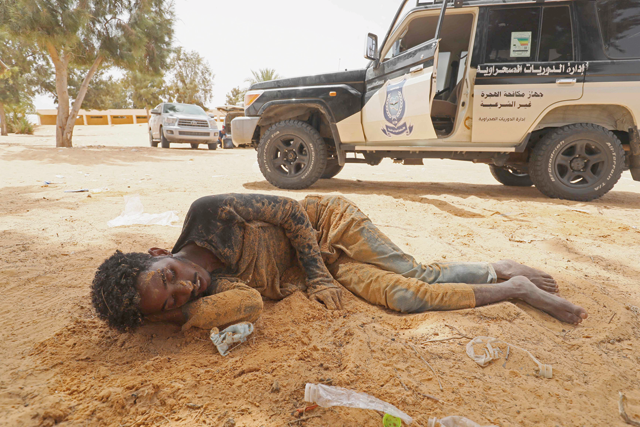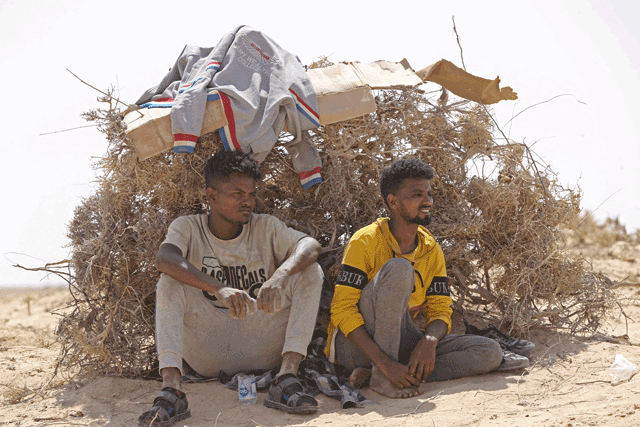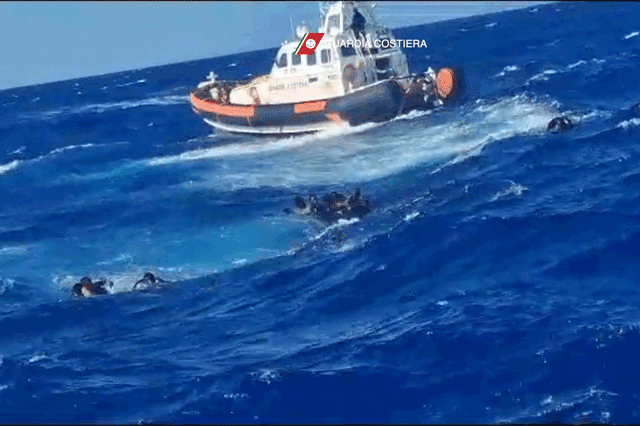You are here
Migrants between life and death in Tunisia-Libya desert
By AFP - Aug 02,2023 - Last updated at Aug 02,2023

A migrant of African origin collapses upon his arrival in an uninhabited area near Al-Assah on the Libya-Tunisia border, on Monday (AFP photo)
AL-'ASSAH, Libya — In the unbearable midday heat, a Libyan patrol near the border with Tunisia comes across a black African man collapsed on the reddish-brown desert sand.
He is barely breathing, and officers try to revive him, gently, with a few drops of water on his lips.
The man is just one among hundreds of migrants arriving daily in Libya after being abandoned in the desert borderland by Tunisian security forces, according to Libyan border guards and the migrants themselves.
By the time they reach Libya, the migrants from Sub-Saharan Africa are ready to drop from exhaustion, in temperatures that have exceeded 40°C.
AFP on Sunday witnessed the border guards rescue around 100 men and women from an uninhabited zone near Sebkhat Al Magta, a salt lake along the Libya-Tunisia border.
In the distant shimmering heat haze, six figures emerge, the latest to reach the area. They speak Arabic and say they have come from Tunisia.
Libyan border guards told AFP that, over the past two weeks, they have rescued hundreds of migrants who said they were left by Tunisian authorities in the border region near Al Assah, about 150 kilometres west of Tripoli.
In early July, hundreds of migrants from Sub-Saharan African countries were driven out of the Tunisian port city of Sfax as racial tensions flared following the death of a Tunisian man in a clash between locals and migrants.
Tunisians 'brought
me here'
Haitham Yahiya, from Sudan, said he worked for a year in Tunisia's construction sector after reaching the country clandestinely through Niger and Algeria.
"I was at work when they caught me and brought me here, first in a police car then in a [security forces] truck. Then they left me and told me to go to Libya," he said in Al-Assah.
At its closest point, near Sfax, Tunisia is only about 130 kilometres from the Italian island of Lampedusa.
The North African country is a major gateway for migrants and asylum-seekers attempting perilous sea voyages in hopes of a better life in Europe, whose leaders have offered financial aid to help Tunisia manage the flow.
Human Rights Watch said up to 1,200 black Africans were "expelled, or forcibly transferred by Tunisian security forces" in July to the country's desert border regions with Libya and Algeria.
In mid-July, the Tunisian Red Crescent said it had provided shelter to at least 630 migrants who had been taken after July 3 to Ras Jedir, about 40 kilometres north of Al Assah.
A few days later, though, AFP gathered testimony from hundreds of migrants still stuck in the Ras Jedir buffer zone. They said they had been forced there by Tunisian security forces.
In Ras Jedir, 350 people remained in a makeshift camp, including 65 children and 12 pregnant women.
"Their living conditions are very problematic," a humanitarian official told AFP, adding that "it is not sustainable in the long term, there are no toilets, no water tanks, no real shelters".
At Al Assah, dazed migrants continue to stagger in, some with only sandals on their feet.
In twos and threes or by the dozens, they come. Some collapse. The guards hold bottles of water over their parched mouths.
Faced with the influx, Libyans from the border guards Battalion 19 of the army, and a unit against Saharan immigration, have been patrolling daily.
"We are on the demarcation line between Libya and Tunisia and we see more and more migrants arriving every day," said Ali Wali, Battalion 19 spokesman.
He said AFP received permission to accompany the units "to silence those [in Tunisia] who claim that we fabricated it all and brought the migrants here".
Their patrol area covers 15 kilometres around Al Assah. Wali said that depending on the day, they might find "150, 200, 350, sometimes as many as 400 or 500 irregular migrants".
On this day there are 110, two of them women. There are supposed to be two others. A soldier searches for them through his binoculars.
At least 17 dead
On Thursday, a joint statement from United Nations agencies referred to the "unfolding tragedy" of migrants, refugees and asylum seekers in Tunisia's border regions.
"They are stuck in the desert, facing extreme heat, and without access to shelter, food or water. There is an urgent need to provide critical, life-saving humanitarian assistance while urgent, humane solutions are found," they said.
The UN has also singled out Libya in several reports in the past, denouncing violence against the 600,000 migrants it detains, most of them in camps.
The government of Tripoli has made it known in recent days that it rejects "resettlement" on its territory of migrants arriving from Tunisia.
The migrants, meanwhile, have crossed the border unknowingly. They walk, they said, in the direction that the Tunisian security forces told them to go — towards Libya.
As a heatwave has suffocated the Mediterranean, some like Alexander Unche Okole said they had walked for two days, without food or water.
Okole, 41, from Nigeria, said he entered Tunisia via Debdeb in Algeria, and "spent some time in Tunis but then the Tunisian police got me. They arrested me in the street and then took me down to the Sahara desert".
He showed a mobile phone whose screen was smashed, he said, by the Tunisians.
"With the Grace of God, the Libyans rescued me" and provided food and water, Okole said.
He survived but others have not.
Wali said officers found two bodies on Saturday, a couple of days after recovering five more including a woman and her baby. They had also discovered five corpses a week earlier, he said.
"How do you expect them to survive? The heat, no water, and a march of two, three days?" Wali asked.
Humanitarian groups in Libya reached by AFP gave a death toll of at least 17 over the past three weeks.
Related Articles
AL ‘ASSAH, Libya — Libyan border guards have rescued dozens of migrants who have been left in the desert by Tunisian authorities without wat
TRIPOLI — An Arab rights group called on Monday for international help for 360 sub-Saharan migrants who Libyan authorities say were rescued
TUNIS — Tunisia and Libya announced Thursday they had agreed to share responsibility for providing shelter for hundreds of migrants stranded

















